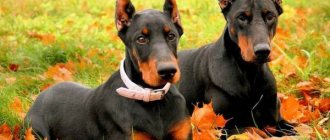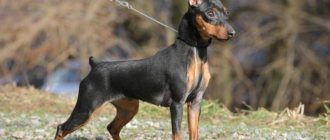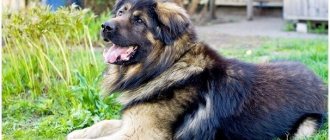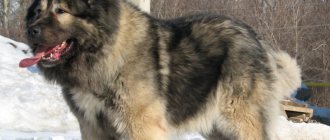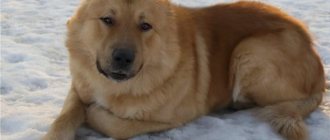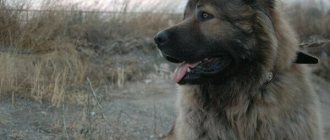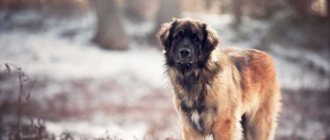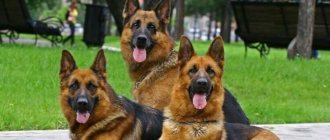The Shepherd is a very noble and loyal animal that is very popular. Many dog breeders and dog kennel owners breed new breeds of dogs by crossing their best pets with representatives of other breeds.
With such crossing, the qualities of both parents are transmitted from the parents. A mixed-breed cross between a German and Caucasian Shepherd is a prime example of this. The animal inherits both the appearance of both parents, as well as habits and character. The mestizo finds its application in security and guard duty.
Characteristics of breeds
The distinctive features of the Caucasian Shepherd are its intelligence, courage and independence. These are fearless animals, ready to fight even the most dangerous opponents.
Mixed Caucasian with German
The main feature of the “Germans” is considered to be their increased intelligence and intelligence. These are sensitive and courageous animals, with increased activity. They get along well with children and are very friendly to others.
The mixture of will, determination and independence of the Caucasians with the playfulness, intelligence and friendliness of the Germans resulted in an excellent mixed breed with a combination of the best qualities of the two breeds.
How are they similar?
- Both of these shepherds are smart, quick-witted and highly trainable.
- They both have a protective instinct by nature.
- Both the “German” and the “Eastern” are able to sense the mood of the owner and act in accordance with it.
- Both breeds are distinguished by strength, endurance, courage and viciousness, as well as distrust of strangers.
- Both dogs are unpretentious to living conditions.
NOTE!
With proper training, both the “German” and the “Eastern” make wonderful working dogs: loyal, reliable and hardy.
Who are mestizos
By mestizos we mean offspring that are the result of crossing between several breeds. Most often, it surpasses its parents in characteristics. They may be less aggressive and more resilient.
Important! In most cases, mestizos are bred purposefully.
A purebred breed has characteristic habits, character traits and color. But their problem is susceptibility to genetic diseases. In contrast, mixed breeds are more resilient, but they have behavioral difficulties.
A lot of positive traits are manifested in the character of mestizos. They turn out to be friendly and good friends for children. But at the same time they retain excellent security qualities. Such a dog is sensitive to a person’s mood and will never let an enemy near its owner.
Mestizos are loyal and devoted friends
Basic articles about NO and her puppies
So that you can identify a German Shepherd yourself, you need to consider:
Topline of a German Shepherd
The German Shepherd has a strong, powerful body structure without looseness or heaviness - a torpedo dog with a flexible, elongated body and a smooth topline. The top line is a line passing through the thoracic, dorsal and sacral sections of the spine, that is, it begins at the withers and ends where the tail is “attached”.
In a well-developed physically dog, without internal diseases and physical abnormalities, this visual line runs smoothly, is perceived as uniform and does not have clearly defined segment boundaries or depressions (overtracking, “saddle” or humpback).
Important! Unlike many other breeds, the topline of the German Shepherd is not traced from the withers or neck, but from the tips of the high-set ears to the very tip of the saber-shaped tail. Throughout its entire length, the topline should be “drawn” in a single smooth movement.
Advice. Ask the breeder to place the dog sideways to you, against the light, and take a classic stance. Stand back a few steps so you can see the whole dog.
Frame
Also pay attention to the length of the body and the height of the shepherd dog. If the height of the dog at the withers is equal to or close to the length of the body (square format), and its height (height at the withers) clearly exceeds 60-65 cm, turn around and leave - this is a real shepherd mix!
Mixed-breed puppies adopt the square format, barrel chest, and irregular topline of one or both parents.
In a purebred puppy, the top line runs smoothly and long from the occipital protuberance to the tip of the tail without interruptions, remaining this way from birth to the end even during the period of growth of the baby (from 3 months), when the baby looks funny and awkward.
Movements of a German Shepherd and its paws
No matter how beautiful the dog may seem to you standing, be sure to ask the breeder to show the shepherd in motion.
The usual gait for the HO is a soft, trailing trot, but this may not always be seen in confined spaces. It is enough for the step and body movements to be dexterous, light and relaxed. Stiffness in movement indicates physiological or physical deficiencies, such as dysplasia or diseases of the internal organs, which cause pain for the dog when moving. You cannot adopt a puppy from such a dog! No matter how purebred the shepherd is listed on the documents.
In an adult shepherd dog, the structure of the paw (not the leg, but the paw - foot) has an elongated shape due to the 2 middle fingers slightly extended forward. The paw is not narrow, like a hare’s (“greyhound’s paw”), and not round, like a cat’s, it is aristocratically elongated, but not small, but even and large. The footprint of such a paw is an exact copy of a hard-boiled chicken egg, cut in half.
A German Shepherd puppy's paw only appears round; even in infancy, extended toes with strong, arched bones are clearly visible.
Dewclaws should be removed 3-5 days after birth so that you will not have the opportunity to “suspect” their existence.
Pay attention to the hocks when the dog is standing.
In a purebred German Shepherd (the croup slopes smoothly to the base of the tail), the metacarpal to horizontal ratio should be 90 degrees.
That is, the metacarpus should take a strictly vertical position in relation to the ground.
Advantages of mixed breeds over purebred dogs
Owners of Caucasian Shepherd and Shepherd mixes characterize this species only on the positive side. They become more obedient, friendly, and flexible in character than their parents.
Among the main advantages are:
- The shepherd dog mix is characterized by obedience and a calm nature.
- They get along well with cats and small dogs and love children very much.
- These are reliable and loyal friends for the owner.
- Such shepherd dogs are easy to train and can be trained.
- The pet adapts well to any weather conditions; outdoor living is considered the best option for it.
- Mestizos are not characterized by manifestations of hostility and aggression, which are partly present among Caucasians.
Important ! This species is not intended for keeping in an apartment. Mixed breeds turn out to be very large in size, so they feel most comfortable in enclosures outside, in a spacious area.
Briefly about the East European Shepherd
The East European Shepherd was bred on the basis of the German Shepherd breed in the 20-30s of the 20th century.
When creating the “Easterns,” the main goal was to breed the ideal dog for service in the army and law enforcement agencies, which is why the emphasis was placed on large stature, endurance and physical strength, for which the dogs were crossed with huskies and some breeds of mastiffs.
As a separate breed, the East European Shepherd was recognized only in 1976, despite the fact that already around the 1930s, mainly dogs of this type were bred in the country.
The East European Shepherd is a large dog, whose height is 62-76 cm at the withers. In terms of the shape of the head and general proportions of the body, it is not much different from the German Shepherd, except for the fact that the “German” has a pronounced back, while the “Eastern” has a straight back.
The coat is dense, hard, and medium in length. The undercoat is shorter than the spine and well developed.
The most preferred colors: black and black . Zone-gray and zone-red are allowed by the standard, but are not very desirable.
Advantages and disadvantages
pros:
- Calm and balanced.
- Smart and understanding.
- Differs in devotion to owners.
- Understands when it is time to stop pursuing the offender and return to the owner.
- Patronizing towards children.
- An excellent security guard and watchman.
- Even an elderly person or a teenager can cope with her training.
- Doesn't get into a rage while working, but carries out commands with maximum concentration.
Minuses:
- Serious training is required.
- She may be overly distrustful of strangers.
- Not universal.
- Puppies of this breed are more difficult to raise due to their large size and accelerated growth.
- Sometimes they are very stubborn.
- They like to show independence.
Character
East European Shepherds are calm and balanced. They take their work seriously and responsibly. These dogs have a strong protective instinct, which makes them excellent watchdogs.
Very intelligent and have an excellent memory, just like Belgian Shepherds.
During training and professional use, problems can only arise due to their stubbornness and excessive independence.
Children are treated patronizingly.
They do not harm other people's dogs and other animals, unless they themselves annoy them..
What does a cross between a Caucasian Shepherd and a German look like?
A mixed breed of Caucasian and German Shepherd is a very beautiful dog with a powerful physique and a perceptive mind. Externally, the puppy will look like a Caucasian, but with age it will show features of crossed breeds.
The positive aspects of breeding a mixed breed of Caucasian Shepherd and Shepherd include:
- strong physique, with well-developed muscles;
- medium length tail;
- large head, slightly elongated nose;
- thick, long hair, thanks to which the pet can withstand outdoor conditions well;
- a variety of colors inherent in both Caucasians and Germans - most often the coat color characteristic of German shepherds predominates.
A cross between a Shepherd and a Caucasian Shepherd is very large. Such dogs can reach up to 70 centimeters at the withers.
Important ! If a mestizo's fur is wavy and there are white spots in the color, this indicates that crossing took place with another breed or mongrel. In this case, character traits may be unpredictable.
Appearance of the crossbreed
Working qualities and training
From birth, the German and Caucasian Shepherd breeds are characterized by watchdog and security skills. These dogs were used to herd livestock. They are very diligent and can stay in one area for a long time without changing location.
Outwardly it may seem that the mestizo is very calm, but this is deceptive. If danger appears on the horizon, he will react to it immediately. Thanks to these qualities, a mixed Caucasian with Germans is used for official purposes to organize search operations and protect objects and territory.
Important! Balanced and calm dogs are not empty-headed dogs. They calmly react to extraneous sounds and passing passers-by.
The dog will treat any stranger with caution, but will not show aggression for no reason. He will never attack without warning and will growl first.
The training process should begin as early as possible. Already as puppies, mixed-breed dogs begin to learn commands. It is important that the training process is led by a person who has earned the dog’s trust and become its leader. Training should be carried out in two stages. First, the puppy is trained, and then the acquired skills are consolidated in an adult dog.
The initial task of any dog breeder is to teach the puppy to respond to its name. It is important to call it the same all the time. Once he understands his name, you can start learning easy commands, such as walking.
Important! You should always praise your pet for obedience.
Mestizos need to devote a lot of time from birth. By nature they are very friendly and attached to their owners. Therefore, they need maximum communication. Dogs are inquisitive, so training is successful. They always have an eagerness to learn new commands. If you regularly exercise with your pet, you can achieve lasting results.
Puppy training
Wolf dog character
From a mixture of Caucasian and German shepherd dogs, an amazing combination of all the positive character traits of both one and the other breed is obtained. They combine friendliness, courage and determination with activity and energy. The puppies turn out to be very playful and inquisitive. They are very attached to their owner. We are always ready to actively take part in joint games.
Character traits include:
- calmness and poise in any situation;
- firmness and perseverance;
- lightning-fast reaction in the event of any dangerous situation.
You can never say exactly what kind of character a mestizo will have when choosing a puppy. Experts are recommended to carefully study the habits of both parents.
Metis is an excellent guard
Security qualities
In the past, both Caucasian and German Shepherds were herding dogs, so they naturally have guarding and protective functions. A puppy mixed from these two breeds will have innate guard instincts, and he will cope well with the role of guarding the house and the territory entrusted to him. These huge animals skillfully choose an observation point for themselves, from which they can see all the surroundings and can stay there for hours without even changing their position. But the dog’s calm and tranquility is deceptive; it is always on the alert and ready to react with lightning speed to any threat.
The hybrid will not bark for no reason; it calmly reacts to passing cars, extraneous sounds and people passing by. The dog, in whose veins the blood of Caucasians and Germans flows, is able to adequately assess the situation and make decisions independently. They are distrustful of strangers, but they do not have the aggression and anger inherent in representatives of the Caucasian breed. The half-breed will not immediately rush at the stranger, but will warn him with a threatening growl that he should not come closer.
The crossbreed is distinguished by its flexible character, easy to train, and friendliness to other animals.
Unlike the same Caucasian Shepherd Dogs, the hybrid is loyal to other pets. Mixed breeds perceive small defenseless animals, such as cats or toy dogs, as objects that need to be protected. The picture looks quite cute when an impressively sized dog allows a tiny kitten to pull its tail or climb onto its wide back. But mixed breeds do not get along with other large dogs and will prove their superiority in a fight with them. Peaceful coexistence of two such dogs in one home is only possible if they were raised together from a young age.
A mixture of these two breeds is highly trainable; they do not have the stubbornness and willfulness of the proud Caucasian Shepherd Dogs. Mestizos are obedient and disciplined, quickly remember commands and meekly carry out all the orders of the owner.
Subtleties of feeding and care
Mixed breeds do not require special living conditions, but owners need to observe certain nuances in caring for such a pet. Since shepherd mixes are large in size, it is recommended to keep them in private houses with large plots. It is best to equip an enclosure for your dog. Metis needs daily walks, active games, and running.
One of the distinguishing characteristics of mestizos is good health. But you still need to take your pet to the veterinarian for a preventive examination every year.
Particular attention should be paid to nutrition. It is necessary to exclude from the diet foods that the parents of the mestizo do not eat. They will be poorly absorbed due to genetic predisposition. It is not recommended to give your dog:
- any smoked meats;
- flour products;
- sweet;
- food with spices.
Since mixed breeds have long and thick hair, it must be combed with a stiff brush at least twice a week. During the molting period, it is recommended to carry out the procedure daily.
Crossing a Caucasian with a German gives an excellent result in the form of a good-natured, but reliable and loyal mestizo. This will be a real guard and friend who will protect the owner and have fun with him.
Briefly about the German Shepherd
Description of the breed
This is one of the most famous dog breeds in the world, if not the most famous. Despite the fact that the original purpose of German Shepherds was to herd livestock, the characteristics of their character and temperament made these dogs suitable for any service.
“Germans” not only serve in the army and police, but also work as rescue dogs or guides for the blind.
German Shepherds also go in for sports, and they can master any kind of sports. And, of course, German shepherds are wonderful guards and bodyguards.
It is not surprising that all over the world these dogs are most often chosen as guards for private houses and city apartments. After all, the endurance and unpretentiousness of shepherd dogs make them suitable for living in a wide variety of climatic conditions.
The German Shepherd is large in size: it is 50-65 cm, and its weight can reach 30-50 kg .
Her body format is somewhat stretched out, but at the same time the dog looks harmonious and not too squat. The length of the head is approximately equal to 40% of the height at the withers, while the skull and muzzle are equal in length.
From above, the head resembles a wedge: wide at the top, it tapers towards the nose. The ears of the German Shepherd are not very large, erect, in the shape of a triangle with a wide base.
The eyes are oval, the look is intelligent and alert. The nose is quite large and black. The neck is strong, strong and muscular. The withers are well defined, the line of the back is even, slightly lowered.
The croup slopes down and meets the base of a saber-shaped, slightly curved tail . The forelimbs are smooth and straight, the hind limbs are strong and muscular.
The color can be black, dark or light gray, black and tan, zoned, saddleback, and also red of various shades. White German Shepherds are also bred in America, but this color is not recognized in Russia.
The German Shepherd can have both coarse and relatively short hair, and longer, forming fringes on the ears, limbs and tail..
Advantages and disadvantages
pros:
- Smart and easy to train.
- He is distinguished by exceptional devotion.
- Unpretentious - easy to maintain.
- They treat children well.
- They are able to distinguish a “work” situation from an everyday one.
- Well guarded.
- A versatile service dog suitable for any job or sport.
Minuses:
- It is necessary to seriously engage in training.
- The German Shepherd needs a lot of physical exercise.
- Not a lap dog, but a working dog who should have his own business.
- May show excessive aggression if improperly raised.
- Dogs of this breed can be hyperactive.
- Nervous breakdowns are possible during overtraining.
Character
The German Shepherd is an attentive, obedient and incorruptible service dog known for its courage and determination.
Quite angry and distrustful of strangers, at the command of the owner she is ready to attack the intruder at any moment.
At home, she is calm and friendly towards the owner and members of his family.
Dogs for protection. German or Caucasian?
Common breeds of guard dogs in the CIS are German and Caucasian shepherds. The German is a dog of medium height with a harmonious build. In Europe, they did not want to breed such dogs for a long time due to their wolf origin. The main feature of this animal is its intelligence, and the first person to take up the breed was a German officer. From a proud dog, he made an impeccable soldier who had a good scent, endurance, was obedient and fearless. During wartime, the Germans were able to realize their full potential. Today, German shepherds are used not only to guard military facilities and customs control, but also as a home guard and pet. This breed can be easily raised and trained by both experienced dog handlers and amateurs.
Dogs feel very good both in large spaces and in apartments, of course, provided they are walked regularly. The enclosure for a German Shepherd must be spacious and high enough and meet safety requirements. The dog can be trained from an early age and does not need any special techniques. An adult guard is very proactive and can lead dogs of other breeds. German Shepherds are tied to their territory, to their enclosure. During skirmishes with the enemy, well-trained dogs try to disarm him and immobilize him until an authorized person arrives; at the same time, irreparable injuries to the enemy are rarely inflicted. Over the years of service on the borders, German shepherds have detected thousands of offenders.
One day, when my friends and I were going fishing, a grandiose mansion appeared on our way. And everything was calm until we saw the silhouettes of three huge dogs: two Caucasians and one German. Moreover, the German barked furiously at us, running from side to side, and the Caucasians obediently rushed after him. The problem was that the road we were walking along was very narrow - only three meters from the pond, and the dogs did not look very friendly. When we finally decided to continue our journey, another surprise awaited us - the Caucasian Shepherd easily jumped over the barrier and began to show us its grin already close. I was amazed by the fact: although the shepherd was so close that its drool flew onto our trousers, but since we did not come closer, the dog did not attack us. The maximum weight of a Caucasian Shepherd is seventy-five kilograms, which is almost twice as much as the weight of a German; These are very strong, powerful and fearless dogs. They have an innate guardian instinct. The very sight of this huge animal can prevent illegal entry into the facility. Dogs are calm by nature, but can sometimes show outbursts of aggression.
Caucasian Shepherd Dog vs Pit Bull – Breed Comparison
Their similarity is that both dogs are fighting dogs, but the Caucasian has a big advantage: he is used to fighting to the death. Almost every fight he fights is a battle for life. And if a pit bull fights one on one in the arena, then a Caucasian Shepherd can fight with a whole pack of wolves.
disadvantage over the BUT is the lack of hair, while the shepherd's hair is knitted and thick.
The Caucasian Shepherd Dog is less amenable to obedience and training, the Pit Bull has more tolerance for children, and as a bodyguard the Shepherd Dog is superior to it.
Briefly about the VEO breed
When Soviet Russia needed large, friendly dogs with excellent working qualities, the choice was made in favor of German shepherds. They served as the base breed for a new type of dog, designed to replace the light German type with serious dogs, suitable, first of all, for military service in various climatic conditions, and then for other “needs of the national economy.”
Planned, targeted selection to improve dogs imported from Germany began in 1924.
The dog was literally “calculated” by domestic breeding specialists from the Service Dog Breeding section of the All-Khotsoyuz. A little later (1928-30), breeders of Osoaviakhim and departmental nursery schools for breeding service breed dogs joined their work.
Over 4 decades, departmental nurseries and public organizations have done a tremendous amount of work to improve the constitutional characteristics and develop the desired performance qualities of the German Shepherd.
The resulting large group of purebred dogs differed sharply from German standards, clearly passing on their improved qualities to their descendants.
These external differences and qualitatively different working qualities, which emerged as a result of long-term focused work with the German Shepherd, allowed the Canine Council of the USSR Ministry of Agriculture to accept a new breed, like the East European Shepherd Dog in 1964, with the establishment of a fixed unified standard for it - the VEO breed type.
Features of dog breeds
Initially, special requirements were placed on herding dogs:
- they must be extremely resilient, since they have to work around the clock;
- a thick coat should protect from harsh climates;
- they must be fearless and strong, since while protecting the herd they have to deal with predators;
- the hunting instinct, which can lead far from the herd, should be kept to a minimum.
All these requirements were taken into account to one degree or another when breeding shepherd dogs in different countries. The emphasis was on local climatic, geographical features and color types.
However, this does not mean that dogs bred in one country cannot live and work in other countries and even continents. So, we all know and love the Scottish Shepherd (Collie), Central Asian (Turkmen Alabay), Belgian, Caucasian and, of course, the favorite of canine beauty - the German Shepherd.
What character traits distinguish the two breeds and how are they similar?
The behavioral differences between the East European and the German Shepherd are small: the two breeds are based on a single line of old-type “Germans”.
Both dogs are perfectly manageable
VEO favors those who work directly with her - personal contact is important. The German Shepherd willingly works with anyone who can give it the pleasure of working.
Both are completely fearless (if raised correctly)
A balanced psyche makes shepherd dogs a worthy opponent for psychological pressure from a stranger. Both are capable of active physical counteraction.
Temperament and training
Temperament is what separates these two breeds completely!
East European Shepherds are calm and slow, they master the basics of training without any problems, although even at a young age they are not averse to “scraping” when developing elements.
German Shepherds are fast, agile and agile, like mercury. Such a temperament can create problems during training, including rough physical influence from the owner.
But they have no equal in achievements based on results in complex, special training courses. “Detention” for IOs is an indicator of temperament. The dog becomes so enraged that it can be difficult to tear it away from the detainee.
For VEO, “detention” is a job that must be done efficiently. The dog does not experience rage or malice, which is why the East European Shepherd is able to track the movements of the detainee’s hands and intercept the other hand if he has thrown an object (stick, knife, pistol, etc.) from palm to palm.
Differences in the temperament of breeds developed gradually and depend on their morphological characteristics and the purposes for which the dogs were bred.
The German Shepherd is softer and more pliable in training with full contact with the owner, however, it is more prone to hysteria and psychological breakdowns when overtrained.
The Eastern European, due to its extremely balanced character, is not prone to hysterical breakdowns, but can be stubborn to the point of breakdown of the owner’s nervous system, although the dog itself has an excellent memory and is very understanding.
Both breeds love and know how to work – there is no difference between them!
If BUT requires a person who clearly understands what he wants to get from a dog, he will get it: the German Shepherd is good because it is very “plastic”, which is why it is universal. But sometimes she also needs to show “who’s boss.”
VEO is NOT a universal dog, although it can be repurposed with some effort. Her main orientation is service and security - she herself knows what needs to be done.
An old man or a teenager can handle the training and education of a VEO, unlike training a German Shepherd.
Characteristic differences in growing puppies
If you still decide to buy an “unconfirmed” puppy, then pay close attention to its appearance so as not to repent later. A dog is purchased for more than one year! If you want to get a faithful friend, whose meaning of life is contained in the motto: “Serve and protect!”, then you need to remember the main signs by which you can distinguish a shepherd from a mongrel.
Do not purchase a puppy before he is 3-4 weeks old!
Until this age, it is difficult even for a specialist to distinguish a HO (German Shepherd) from a large mongrel. By the age of one month, the baby develops characteristics characteristic of a purebred shepherd dog - generic differences.
Eyes
The BUT puppy's eyes are set slightly askew, have an almond-shaped cut , and when the baby turns his head, trying to look at a new object for him, the pure white white of the eyeball . Because of this eye structure, the shepherd's gaze is often compared to a human's. Such eyes are found in the “German” and in the East European Shepherd puppy.
The rainbow arch is from dark yellow to deep brown. Up to 2 months it can be blue or light blue. The look is lively, expressive, curious and playful.
Mongrel puppies have round, slightly protruding eyes. When turning the head, the protein stands out weakly, the color is yellowish or with dark spots. The gaze may be lively and curious, but it cannot be compared with a human one.
Clearly standing ears at 1.5-2 months old in a puppy is what distinguishes a mongrel from a shepherd dog 100%! A German Shepherd's ears don't stand up at this age! Large and soft ears of shepherd dogs appear by 6-8 months.
Moreover, often the ears first stand up like a house, then they fall, then they stand up one by one, and so on until they are completely fixed on the top of the head.
From the age of 3 months, puppies begin to change their baby teeth to permanent ones. At this time, babies’ ears are always “in decline.”
Are there significant external differences between the two breeds?
To get a clear picture of the similarities and differences between the breeds, check out the table below:
By comparing the parameters, it is easy to determine that the Eastern European type is much larger and stronger, capable of withstanding greater physical (service) loads.
For BUT, a rich, “elegant” color is important.
For VEO, color is of secondary importance - it does not in any way affect the character or working qualities of this campaigner.
What are the differences?
East European Shepherds are larger and more massive than German ones: their height is about 10 cm greater. But the main external difference between these two breeds is their structure.
If the “German” has a back inclined from the withers to the base of the tail, then the “Eastern” has practically no slope.
In addition, the front limbs of the German Shepherd are longer than the hind limbs, while the Eastern European has all the legs of approximately the same length.
The type of movement is another external difference.
“Germans” move at a measured and free trot, and “Easterners” move at a sweeping and fast gait.
These breeds also differ in temperament: German shepherds are choleric, while Eastern European dogs are phlegmatic. And, if the former are distinguished by impetuosity and speed of reaction to an immediate threat, then the latter are calm and unperturbed.
German Shepherds act impulsively when detained and, if they get into a rage, it can be difficult to stop them.
The East European Shepherd acts deliberately and carefully: it monitors the actions of the detainee and therefore it is not easy to take him by surprise.
“Germans” are a universal breed, but “Easterns”, originally bred for protection, are mainly used as watchdogs.
Which shepherd is better, according to dog handlers?
Both breeds are equally valuable as service dogs, if we are talking about the service qualities of the dogs, and not just their appearance.
You should choose NO and VEO based on the temperament, capabilities and character of the future owner. An experienced breeder or dog handler who knows the breed qualities of shepherd dogs will help you choose a dog “according to its character.”
For people who like to be on the move for a long time, to participate in sports and speed competitions, according to dog handlers, a German shepherd is suitable. With proper upbringing and stopping teenage aggression, BUT makes a great dog!
The East European type of shepherd is more suitable for calm, balanced people who have their own country house.
To say that such a large dog with enormous security potential would be uncomfortable in a city apartment is an understatement. In addition, a narrow personal space can provoke open conflict with people living nearby.
Whatever breed you choose, you are prohibited from jumping over the barrier until the end of adolescence!
Shepherd dogs grow rapidly, rapidly gain weight (and VEO puppies are much heavier than BUT puppies from birth), attempts to “take the barrier” can turn into a disaster!
Dislocations, sprains, and torn ligaments can cripple a dog for life.
Central asian shepherd dog
The Central Asian Shepherd is one of the most ancient breeds of dogs living next to humans.
Alabai
People who have not had close encounters with Alabai are absolutely sure that such dogs are aggressive, angry, and uncontrollable. Fortunately, this is not the case; such dogs simply do not accept life on a chain. They are very freedom-loving. If correctly and don’t forget about training, the Alabai becomes your person’s friend and partner.
According to the standard, the average height of an alabai is 0.75 m. up to 0.85 m in males, females a little lower.
How to distinguish a German Shepherd puppy from an Eastern European one
The difference between VEO and NO is visible from infancy.
You can choose a baby by comparing the height and weight charts for Eastern and German Shepherd puppies.
In a normal litter (5-8 puppies), the weight of the monthly VEO should be at least 3 kg 600 g. Usually - 4 kg 200 g.
With such weight and height, the thickness of the paws (the girth of the metacarpus is wider in comparison with BUT), the puppies seem like baby elephants, not bear cubs, they move clumsily and clumsily.
They are much larger than puppies of the same age, with good volume, with a wide, deep, well-developed chest.
The back is the main difference between puppies of two related breeds! The difference between the points of the withers and the croup in VEO puppies is almost invisible.
Is it possible to determine the future of a puppy based on the documents and titles of the parents? - No. Both the East European Shepherd and the German Shepherd produce puppies in the same litter, both show class and average.
Whoever is better for your purpose (show career or service and protection) is the one you should take.
Differences up to one month of age
If anyone who has ever encountered pedigree dogs of this group can already distinguish a shepherd from a mongrel at the age of 5-6 months, then not everyone will be able to make the right choice at the age of 3-4 weeks. What should you pay attention to at such a tender age?
Mom and Dad
Never buy a puppy without making sure that its parents correspond to the breed characteristics of the German Shepherd. The best evidence in this case is the correct documents for the parents and the children themselves.
To reassure yourself, you should call the club and find out if mom and dad are registered there.
Attention! The club may refuse permission to breed if one of the parents has hip dysplasia.
This is a hereditary disease (genetic predisposition), the symptoms of which may appear only at 6-12 months of age: lameness, increased fatigue, joint pain, unsteadiness of gait, X-shaped stance of the hind limbs.
Hip dysplasia is a real scourge of large breed dogs (which includes the German Shepherd). Treatment is long, painful and not always effective.
Brand
Confirmation of documents is a mark on the inside of the hind paw of both the parents and the puppy itself. Plus the metric, of course.
The stamped mark and the information about it in the metric must match!
If the baby does not have a mark, then, most likely, the mating was “left-handed”; the club did not give permission for it. Such a puppy can be purchased as a pet - this is a real shepherd dog, which has received breed characteristics from its parents, both in appearance and psyche, but the path to the ring will be closed to it.
Who is more picky about feeding?
The German Shepherd can be fed with ready-made high-quality food no lower than premium. These dogs can also eat natural food based on animal protein products.
Experts recommend feeding the East European Shepherd with natural food..
Due to the fact that such large dogs have problems with the musculoskeletal system during periods of active growth or in old age, you need to give them enough soft cartilage and add drugs with chondroprotectors to their food, which the veterinarian will recommend.
Which breed should you choose?
When deciding who, after all, to get - a “German” or an “Eastern”, you need to focus on the purpose of the pet and the conditions of detention.
IMPORTANT!
For people living in a city apartment, their choice should be a German shepherd, since the Eastern European is not suitable for apartment living due to its large size and the fact that this dog needs a large living space.
And those who live in a private house need to decide who is more suitable for them in terms of temperament and character traits: an energetic and very active “German” or a calm, reasonable and imperturbable “Oriental”.
The German and East European Shepherd are related breeds, but there are many differences between them . First of all, they relate to character traits, temperament and official use.
The German Shepherd is a universal service dog, suitable for any job, while the “Eastern” is more focused on guard duty. He is more balanced and not as mobile as the “German”, who constantly needs to be at work, to be on the move.
It is also important to take into account that the German Shepherd is valued as a show dog, while “Easterns” are bred mainly from working lines.
